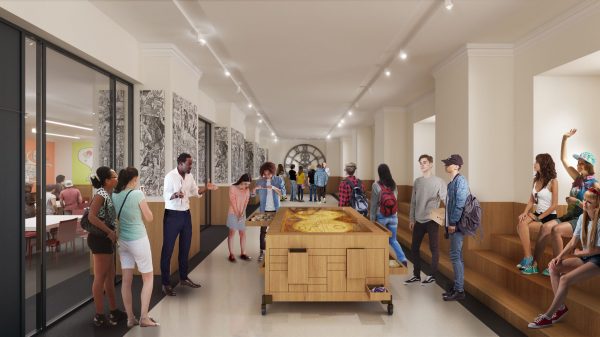2018 School Spending Survey Report
NYPL Unveils Plans for Schwarzman Building
At a November 15 board of trustees meeting, New York Public Library (NYPL) administration unveiled the master plan for renovations to its main branch, the Steven A. Schwarzman Building on Fifth Avenue and 42nd Street in Manhattan. The work is part of NYPL’s Midtown Campus renovation, which includes the gut renovation of the Mid-Manhattan Library across Fifth Avenue, currently in progress.

Schwarzman Building new 40th Street entrance
Rendering by Mecanoo with Beyer Blinder Belle
PHASES II AND III
The $317 million plan represents phases II and III of a three-phase project; Phase I dates back to 2006, and included the build-out of a second level of the underground Milstein Research Stacks and the system to deliver those books to the Rose Main Reading Room. The work that comprised Phase I was funded by $144 million from New York city and state, the largest portion of which was $50 million for cleaning the building’s façade. Phases II and III will be funded entirely through private donations. NYPL already has the $145 million to cover Phase II in hand. Phase III will run to $28 million; the library has $19 million in hand and, said NYPL chief operating officer Iris Weinshall, "we're pretty confident that we'll be able to raise the [remaining] $9 million, either through naming opportunities or other philanthropic gifts." After NPYL’s original Central Library Plan (CLP), first announced in 2008, was abandoned in 2014, the library selected the Dutch firm Mecanoo as design architects and the New York–based Beyer Blinder Belle as architects of record to move forward with a new concept for the two buildings that comprise the mid-Manhattan campus. After a year and a half spent collecting usage data and interviewing users, staff, and community stakeholders, the architects released their preliminary design for Mid-Manhattan in fall 2016 with plans to further study ideas for improvements to the Schwarzman Building. When Mid-Manhattan closed in August in preparation for construction, its collections and staff moved into swing spaces in Schwarzman, many of which were upgraded for their temporary occupants. Although this means that much of the larger-scale structural work at Schwarzman will need to wait until Mid-Manhattan reopens in 2020, some of the Phase II infrastructure work—such as adding HVAC capacity—can begin in 2019 with these spaces still occupied. Work on the elevators and new entrance will have to wait until Mid-Manhattan staff and materials have moved back across the avenue. “It's going to be very noisy; it's going to be a very complicated project,” said Weinshall. “Likewise, we're going to renovate all 22 bathrooms in the building. That's going to require shifting staff around” to space currently used for storage.BUILDING A CAMPUS

Proposed Center for Reading and Learning
Rendering by Mecanoo with Beyer Blinder Belle
CONSIDERING THE STACKS
One aspect of the Master Plan that has not yet been addressed involves the building’s seven floors of central stacks. Currently, they house the Mid-Manhattan Library’s circulating books. But once construction is complete at Mid-Manhattan, the 175,000 square feet of space will be freed up to play a new role; the stacks have been deemed unfit for the research materials they once held, as the space lets in too much natural light and does not meet modern standards for temperature, humidity, or fire safety. However, they are structural support elements of the building and so cannot be removed entirely. The initial CLP called for the space to be rebuilt with modern facilities, with the books they held relocated to an off-site storage facility. Public outcry at the idea of the research collection’s move—along with the economic downturn of 2008—helped sink the first CLP, so now much of the collection is currently held in the underground Milstein stacks, with some at NYPL’s shared ReCAP storage facility in New Jersey. The library is now exploring new options for the space. Much of the analysis done for the CLP is still usable, Weinshall told LJ, and will be supplemented by further study. In addition to a study by the project architects, she said, “We're going to be putting together a panel of some experts—thinkers, urbanists, other architects—to imagine what if. What if you had 175,000 square feet in Midtown Manhattan, what could the space could be used for?" The architects have already begun talking to library staff, and NYPL will be reaching out to more stakeholders. Weinshall predicts the process, which will also involve public meetings and input, will take nine to 12 months. "We're not presupposing anything, nor are we going to present a fait accompli to the public,” she noted. “We'll probably end up presenting a number of options." Added Weinshall, "We want as many suggestions as possible, because the sky's the limit." A video about the renovation can be viewed below.RELATED
RECOMMENDED
TECHNOLOGY
ALREADY A SUBSCRIBER? LOG IN
We are currently offering this content for free. Sign up now to activate your personal profile, where you can save articles for future viewing









Add Comment :-
Comment Policy:
Comment should not be empty !!!
Jim C.
Here's an idea for the space. Keep using it for books. Very few rarities were stored in those stacks, just good solid reading copies for the research collection. So this environmental concern is nonsense. Btw, about 40 percent of Mid-Manhattan's circulating collection was weeded down prior to the closure. When eventually combined with SIBL down the street, those two together will contain half the books they once had.Posted : Mar 11, 2018 10:02